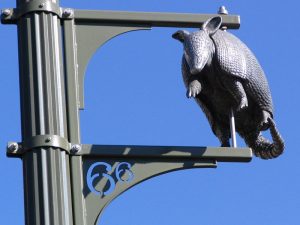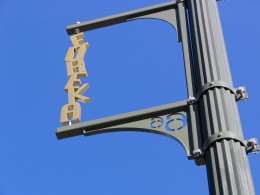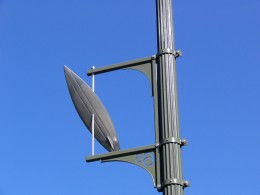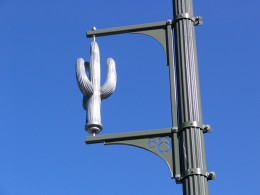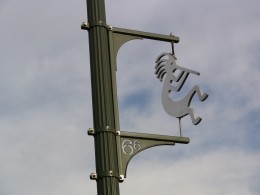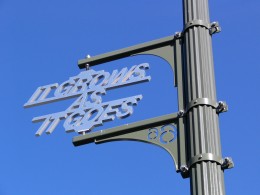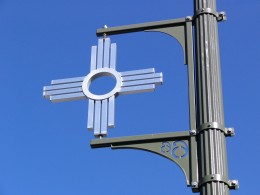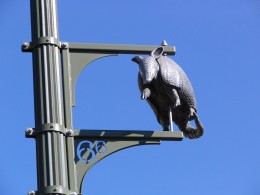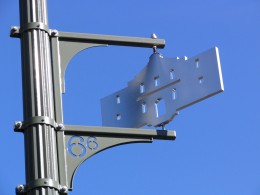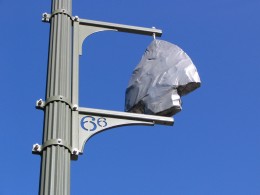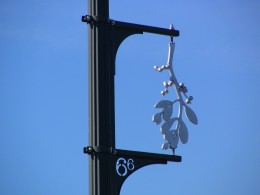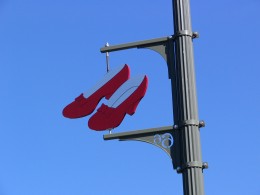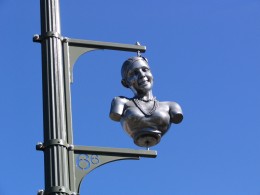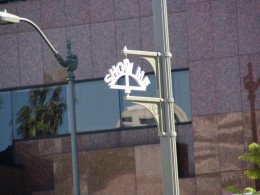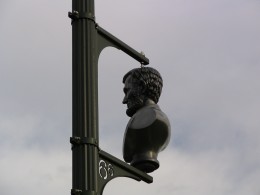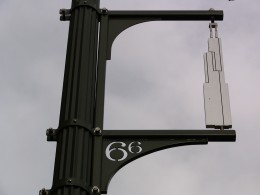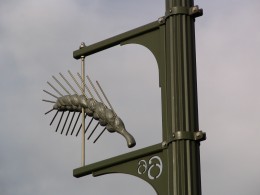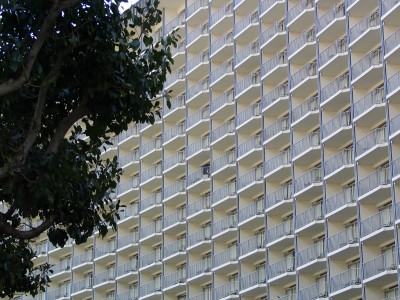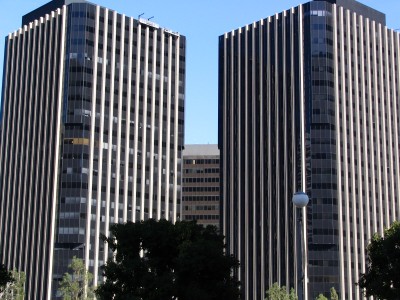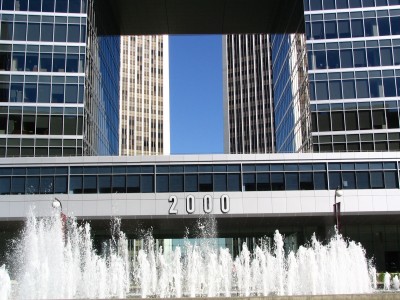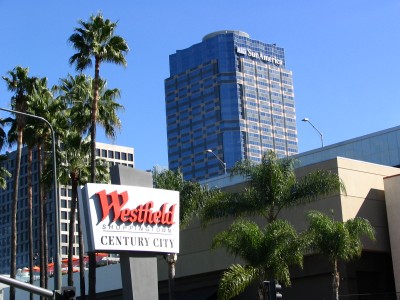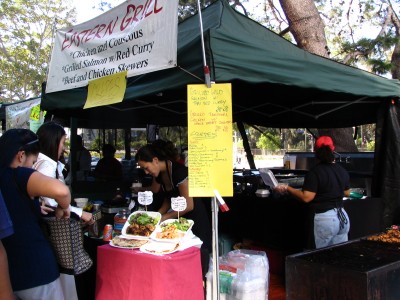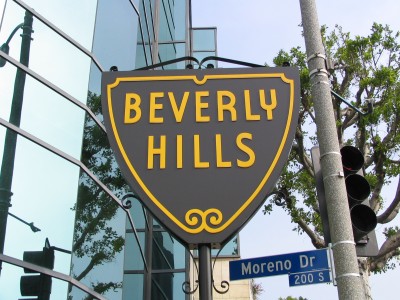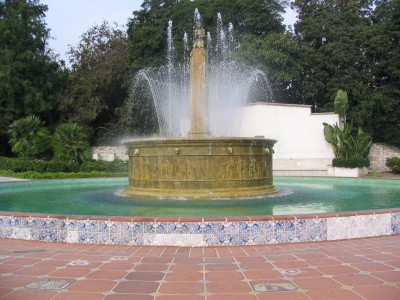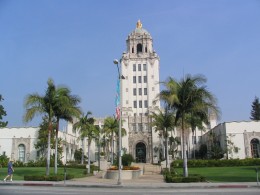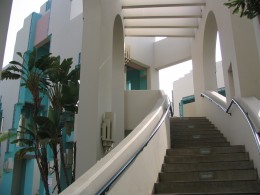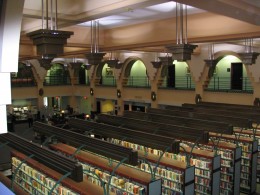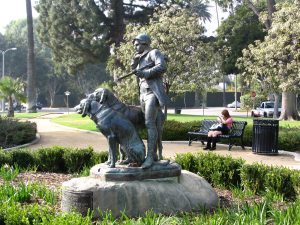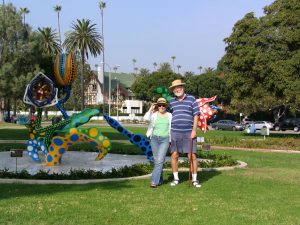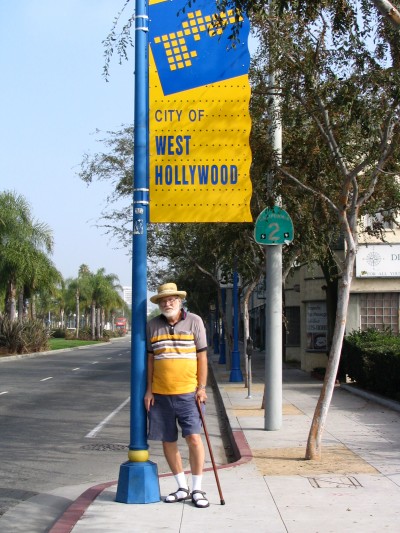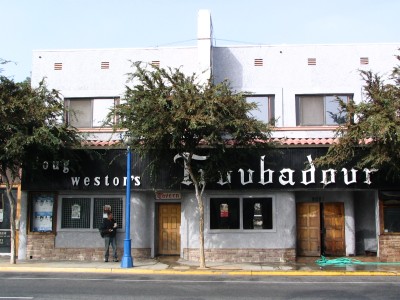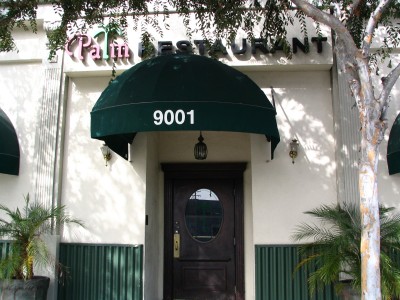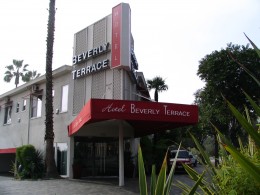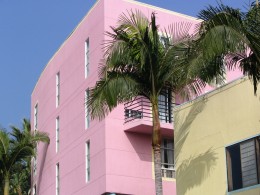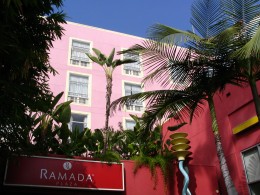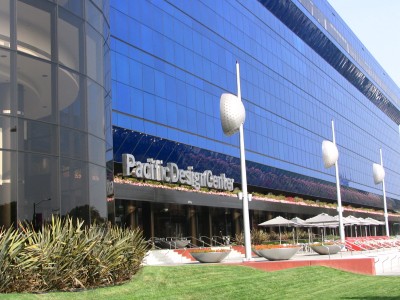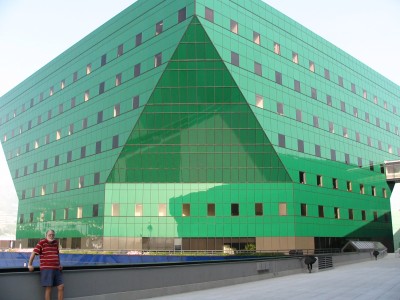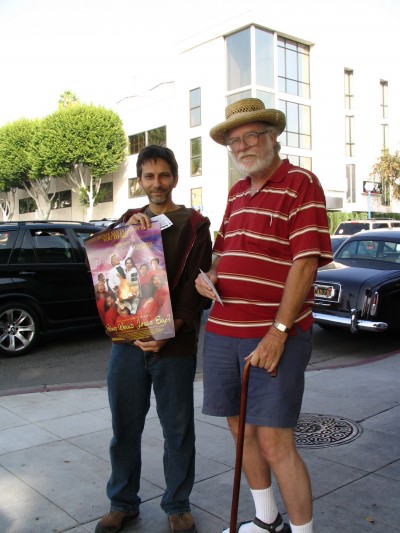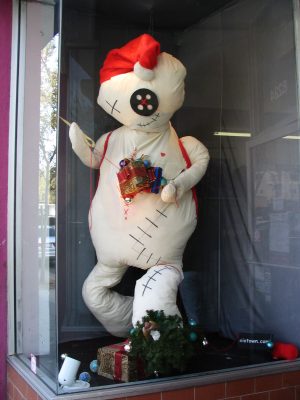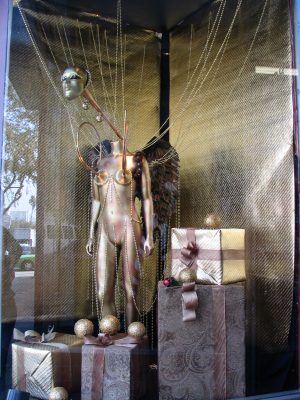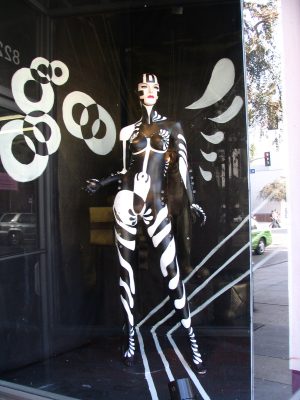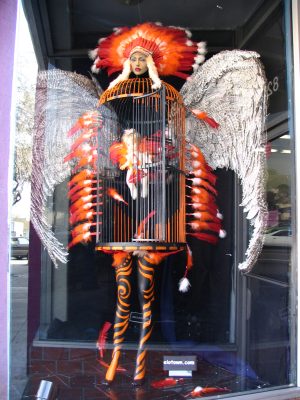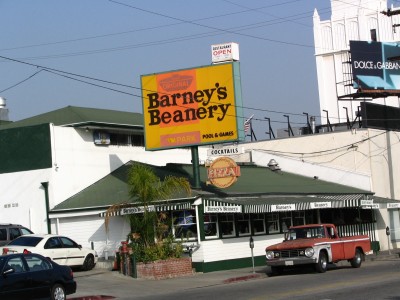It took quite a few years, but the expansion and renovation of Santa Monica Boulevard from the 405 freeway to the Beverly Hills city limits is now complete. There are medians, local access streets, and even the plantings have started to take hold. In Century City the transformation is the most sweeping, with wide turn lanes that make traffic flow much more efficiently than it used to. Now you have only the bottleneck in good old 90210 to contend with, and that’s always bad, except on Sundays.
Part of all that construction, and a part that I’ll bet not one out of a hundred motorists notice as they drive through, is something that I’m calling the Route 66 Memorial. I’ve been unable to find out anything about it online, but I’m betting it’s part of some public art ordinance or something like that, where a small fraction of new roads and public buildings has to be spent on—all too often—bad sculpture or paintings. Each of the Metro Rail stations, for instance, is decorated in a different style, some quite good, some really awful. This 66 thing has to be one of the most obscure.
For one thing, it’s all mounted up at the top of the new lampposts, far out of normal vision. For another, it’s far from monumental. I only noticed it one day when, stuck in traffic, I looked up and thought I saw … is that an armadillo? What’s it doing in California, impaled on a lamppost, and plated in aluminum? The only clue to its meaning is on the bracket below, where the numerals 66 are punched out of the metal … backwards. That’s right, when you’ve driving on the boulevard, which is how 99% of the people who notice these things at all will see them, they are reversed. Very appropriate for our reverse of the traditional 66 trip, but it seems a miscalculation on the part of the artist, whoever he or she may be.
Some of them are obvious, and some were mysterious for a while. One still has us baffled. I believe we saw them all, but they are widely spaced—only about every 20th post has a 66 symbol on it—and we may have missed one. And one seems to have vanished, though I’m going to look for it again. They commemorate the eight states Route 66 passes through, and they are, in order:
- Eureka
- Surfboard
- Saguaro Cactus
- Indian Dancer
EUREKA … state motto of California.
A surfboard. Obviously California.
A saguaro cactus … Arizona.
An Indian dancer … Arizona.
- It Grows As It Goes
- Indian Sunburst
- Armadillo
- The Alamo
- Arrowhead
IT GROWS AS IT GOES, translation of Crescit eundo, on the state seal of New Mexico.
The Indian sunburst from the flag of New Mexico.
An armadillo, better known from my childhood as a “Texas speed bump.”
The Alamo. If that don’t mean Texas to you, you’re probably Yankee scum.
An arrowhead. This must mean Oklahoma.
- Mistletoe
- Dorothy’s Red Slippers
- Josephine Baker
- Show Me
What looks like a sprig of mistletoe. This is the “state floral emblem” of Oklahoma.
A pair of ruby slippers. First thought: California, the movie business. Then, of course, I realized that Dorothy was from Kansas.
The next one is the conundrum. It’s a bust of a woman in a gown with a pearl necklace, with her hair in what looks like a ‘20s bob. She looks like a black woman, and is probably a singer, but we can’t figure out who she is. She must be associated with Kansas or Missouri. A blues singer? Can anyone help us out? We’ll probably feel silly when we learn her identity, but honestly, we’re stumped.
Update It’s Josephine Baker! Thank you, Mike Stamm.
SHOW ME. Missouri.
Now another mystery. I would have sworn I saw a bust of Lincoln on a lamppost driving by one day, but I looked for it as we walked and didn’t find it. I’m going to try again. And, logically, since each state seems to have two icons, there should be yet another one for Illinois, and another for Kansas or Missouri. Why isn’t there a plaque of some sort on ground level to tell us these things? Because other than the Mormon Temple at the foot of Overland, there really isn’t much else to see on this little stretch of Route 66., though Lee took some pictures of an interesting fountain and some colorful buildings.
- Lincoln
- Sears Tower
- Stalk of Wheat
Update We went back and found Lincoln and the Sears Tower … two for Illinois. And a wheat stalk for Kansas.
Century City
When I first came to Los Angeles in 1967, after the Summer of Love in San Francisco, Century City was a lot of bulldozed ground, with basically one wide street, the Avenue of the Stars, and one building, the Century Plaza Hotel. It all stood on what had been the vast backlots of the 20th Century Fox studios. Backlots were being sold off and developed all over LA at the time. Lots of people wish we had them back, they could be tourist attractions. Universal kept some of theirs and developed them into a huge theme park which has worked out pretty well. But it’s hard to argue that Fox could have made more money than they did with the course they took. Century City today is chock-a-block with tall buildings, a huge financial success.
Back then, like I said, there was only the Century Plaza. Shortly after my friend Chris and I arrived in LA a peace rally was held outside the hotel. President Johnson was inside at a $1000-a-plate fundraiser. The LAPD expected 2,000 protesters, and they got 20,000 to 30,000. They panicked, and waded into the crowd with tear gas and night sticks, beating heads left and right, men, women, children, people in wheelchairs. Harlan Ellison wrote a couple apocalyptic columns about it in the Los Angeles Free Press. Ron Cobb did a cartoon about it that showed LBJ in the far distance at a podium, surrounded by a sea of police helmets close as cobblestones, with frowning cops in the foreground. The prez is saying “Mah fellow Americans …” This was the Los Angeles version of the Summer of Love.
Chris and I weren’t there, luckily enough. We were on Sunset Boulevard selling the Free Press to passing motorists, and doing pretty good at it, too. Some people came running down the street yelling that the cops were rioting, hunting for hippies anywhere they could find them and bashing more heads. We made ourselves scarce, along with a lot of others, until the rumors could be sorted out. When you imagine this scene, your soundtrack should be “For What It’s Worth,” by Steven Stills.
The Century Plaza is still there, but it’s now lost in a maze of larger buildings. There’s the Twin Towers, which were designed by Minoru Yamasaki, the same guy who did the World Trade Center in New York, and are reminiscent of that lost glory, except they’re triangular and full of talent agencies and other entertainment industry folks. There’s Fox Plaza, where Ronald Reagan had a penthouse office post-presidency, back in the days when he no longer had much use for an office. I suppose he ate a lot of jellybeans up there, maybe sorted his postage stamps and drooled a lot. It’s also the building that was used, while still under construction, in Die Hard, with those big explosions up on the top floors. It’s the main offices of Fox studios, which are just to the southwest. MGM has a big building there, too. Other than that, Century City is mostly banks, brokerages, and bullshit, devoted pretty much entirely to making rich people richer. There are at least a dozen banks; I stopped counting. There’s even a building with a big hole in the middle.
Century City looks pretty spiffy if you’re driving through. There are a lot of fountains and landscaping. It’s clean, the avenues are broad, the traffic moves well except when those billions of office workers come boiling up out of the underground garages (including one of the world’s largest, it is said) like angry termites at five PM and start the daily scramble for home without benefit of freeways. (The Beverly Hills Freeway was part of the original plan for the area, but for once Los Angeles rejected a freeway, and so people have to crawl through terrible street traffic to get to the terrible traffic on the I-405 or the I-10.) (I imagine the freeway was stopped because it was going to cut right through Beverly Hills on Santa Monica, which would have ripped the heart out of the community, as other freeways did to so many other communities to the south and east, but the 90210ers had the clout to stop it.)
From the ground, on foot, however, it’s a different story. There are very few people walking around, and we were there at lunchtime, when presumably foot traffic would be at its highest. There’s a big, upscale shopping center, the Westfield Century City, to the west, which I assume has places to eat, and most of the buildings have a restaurant or two, as well, of the sort that close at 5 and make most of their money around noon. The height of the buildings is oppressive. Sure, I know, Manhattan had many much narrower streets and much higher buildings, but the sidewalks are always bustling with people there, wherever and almost whenever you go. Not Century City. It’s sort of the apotheosis of Los Angeles, where the rumor is that nobody walks. (Not true, mostly, but I’ll concede there are fewer walkers than in many other cities.) The buildings don’t have any street warmth, either. By that I mean they sprout right out of the concrete like glass and steel walls, with very little ornamentation, and what public spaces have been created are not built to a human scale. In fact, nothing in Century City is built to a human scale. There are no benches, and very little green space where one could lie on the grass.
But we got lucky and were there on a Thursday, which has to be Century City’s best day, as there is a small farmers market on Thursdays, tucked away in the shadow of one of the skyscrapers. The produce was pretty much the same stuff you’d find at the much larger Hollywood farmers market on Sundays, though the prepared foods were a lot higher end and more expensive. We bought a very nice peach cobbler, just enough for two. There were 8 or 9 food booths, and none of them were serving corn dogs or burgers. One specialized in what they called Thai-Mex. We shared a styrofoam box of red curry salmon for $8 from another place, and it was quite good, but I kept thinking of the Thai-Mex. What could that be about? The pictures looked interesting. Maybe next time.
Beverly Hills, For the Third Time
We’ve now walked through 90210 on Sunset, on Wilshire, and now on Santa Monica Boulevard. It’s still as ritzy as ever.
There is absolutely no street parking in Century City. (Well, there may be a space or two on some of the side streets, but your chances of finding one are minimal.) All the parking is underground, and unless you work there, will set you back at the rate of $3 per 15 minutes, up to a $24 max. We had left off our last walk almost all the way through CC, but still had a bit to go, so we parked in Beverly Hills near the Witch’s House—still undergoing refurbishment—and walked back to the land of banks, brokerages, and bullshit. Lee took a lot more pictures of the fountain there at the intersection of Santa Monica and Wilshire, as we crossed back over the path of our previous walk. It’s a doozy of a fountain, and has a habit of suddenly almost shutting itself off just as you’re about to snap the shutter, then going all tall and misty again as soon as your back’s turned.
We walked down a short alley behind the shops of Beverly Hills, and you’d never guess this was an upscale neighborhood except for the lack of graffiti. Touched base at the place we’d left off, then back, and since Santa Monica Boulevard North is pretty uninteresting at this point, we went down Santa Monica South, which most Angelenos call Little Santa Monica. It parallels the bigger, busier street. There must be two dozen hairdressers in four or five blocks, though few of them call themselves that. One styles himself a “beauty creator.” You can smell the stench of some of the awful stuff women let stylists put on their hair, and it smells the same as any other beauty parlor.
There was a building completely covered on the outside with silver bangles that moved in the wind. This was Maison Martin Margiela, and inside was a tower made of champagne glasses, must have been twenty feet high. They were selling shoes and handbags and such, and the staff was dressed, for no reason I could see, in pale green surgical scrubs. Must be trendy in some way. “Trendy” often zips right over my head.
Other sights:
The Beverly Hills Mutt Club, where you can buy outfits for your dog costing more than I’ve ever paid for any article of clothing. In fact, I don’t doubt some of the stuff in there would equal my yearly budget for duds.
George Michael, a Long Hair Care Center.
Beverly Hills Rent-a-Car, where the Corvette and the Porche are the cheap vehicles.
The building housing Celebrity Society Magazine, whatever that is, which has a very nice public sculpture court, not fenced off, and including that rarity in expensive neighborhoods: park benches that are actually comfortable to sit on, and which you could stretch out if you wanted to. Before the security guard ran you off, of course.
Lee’s collecting unusual gas stations, of which Los Angeles and area have more than a few. There was a good one just before we got to the BH Civic Center … which is very nice. It’s a maze of ramps, most of it fairly new, but harmonizing nicely with the 1920s tower and gold capital of the City Hall itself. We peered through the windows—it’s closed on Saturdays, naturally—and it looked interesting enough inside to merit a return trip. The library is here, too, and it is a very pretty one. I liked the way lights were suspended over the stacks so the rows of books weren’t so gloomy, you could actually read the spines, and yet the rest of the library was pleasantly dim. There’s a very good display of some of their collection of letters and signed photographs, from some very big Hollywood names. There is a hand-drawn birthday greeting from Orson Welles that revealed a talent for caricature I didn’t know he possessed.
And sculpture, and more sculpture. I’ll bet 90210 has a bigger budget for public art than most communities spend on the police department. It’s scattered over the lawn at city hall, and as we turned around to return to the car we walked almost half of the mile-long strip of park that runs alongside Santa Monica Boulevard and is just lousy with sculpture. One is of a hunter and his dogs, and it’s pock-marked with shells from World War One. A lot more fun is what I think of as Audrey 3, 4, & 5, three fanciful plants that remind me of Audrey 2 in Little Shop of Horrors.
What else? Oh, there’s a cactus garden. The long park is broken only by three churches that reach out to the sidewalk. One of them, the All Saints’ Episcopal, is where Dudley Moore skulked around and got a bee up his nose in the movie 10.
West Hollywood
Population 37,000, with 15,000 (40%) of them gay, according to Wikipedia. Most of that number are men, at least going by what you see on the street. I doubt there is a town anywhere in the US with a higher percentage; they are almost the majority. Something else you notice: There is very little excess fat on the streets of West Hollywood. These gay guys do keep themselves in shape. You see some leather boys, and some effeminate men, a few cross-dressers, but most of the guys here are not flamboyant, at least during the daytime. At night and on the weekends, when they dress up and people come in from other areas and swell the population to over 100,000, it can be a different story, as we learned a few weeks ago when we attended the annual Halloween Costume Ball, estimated at half a million people, 250,000 of whom (like us) were dressed normally and taking pictures of the other 250,000. There’s a Gay and Lesbian Pride Parade, too. We’ll have to find out when that is and see it.
West Hollywood is pretty new, as towns go. For a long time it was just an unincorporated area of Los Angeles County (and how it avoided being gobbled up by LA I don’t know), but it became a city on its own in 1984. They are still policed by the LA County Sheriff’s office, which is sort of a shame, I think. I mean, if they had their own police force, they could design their own uniforms. Lots of leather and silver chains, big boots … that’s for the women, of course. For the men, something in pink, maybe, with pearl accents and feather trim, a few rhinestones here and there … don’t take offense, I’m just stereotyping.
But seriously, though the town is way ahead of most places in civil rights for everyone, though it is liberal in a good way in most respects, there are a few areas where political correctness has run amuck. It’s illegal to declaw cats, and there is no such thing as a “pet owner” in West Hollywood. They are to be referred to as “guardians.” Gimme a break.
We began where we left off, at the Beverly Hills Civic Center, where the weekly farmers market was being held on a side street. It was much like the one at Century City, with many of the same faces and booths. At the entrance we were entertained by a brass quintet. I am a big fan of brass quintets, I have all the albums by the Canadian Brass and the Empire Brass, who are even better. These folks were only so-so. The trombone picker was consistently just a little bit flat. Well, what can you do? You know the definition of a trombone? It’s a manually-operated, wind-driven tone approximator. That’s a symphony joke. Want another one? What’s the difference between a bull and a symphony orchestra? A bull has the horns in the front and the asshole in the back. I’ve got a lot more about sopranos, viola players, drummers, and oboists, but I won’t inflict them on you.
Sights:
The Troubadour, a relic of the ‘60s where a lot of bands played before they became household names, including The Byrds, featuring our friend David Crosby, and Buffalo Springfield. It was here that Steven Stills wrote “For What It’s Worth,” after the Sunset Boulevard riots.
A nursery that featured giant topiaries … or something that resembled them, anyway. Real topiary is hedges sculpted to look like animals, but these used a short cut, with bundled peat moss or something, and greenery, including grass, growing on them. Actually more like giant chia pets, right? Impressive nonetheless. I’d seen small ones before, but never giraffes and brontosaurs.
The Palm restaurant, closed at this hour, where the walls are covered with caricatures of some of the famous people who have dined there. I had dinner there one night with the Millennium producers, and Johnny Carson was in one of the booths. Sorry, I just can’t resist name-dropping.
Another upscale used-car dealership, that at least had the grace not to call their iron pre-owned. Such cars! Lee swooned over an Austin-Healey, but she’s always liked little toy cars. I preferred a huge Lincoln, looked like it might have been from the early ‘30s.
Some very interesting architecture around here. I’ll let Lee select some of her favorites to post.
West Hollywood, Part 2
We started the next day by backtracking a little bit, and, technically, going off of Route 66, but only a block. Nothing wrong with taking a little side trip here and there, if it’s to visit something like the Pacific Design Center. This is the most impressive building in West Hollywood and, except maybe for the Disney Center, probably in Los Angeles, too.
It’s actually two connected buildings, one long and low, sometimes called the “blue whale,” the other more or less cubical, but with some interesting angular projections, in a brilliant green. There are plans for a red building. They really knock your eyes out. Every way you look at them, they look different. At night, they change colors in odd and interesting ways.
Inside are hundreds of interior designers, furniture sellers, rug merchants, purveyors of curtains, fabrics … anything you want to decorate your home, as long as you have deep pockets. It used to be “to the trade” only, but now it’s open to the public, and you could spend a whole day inside and not even begin to see it all. The stuff varies from the extremely modern to the baroque, like French and Chinese, but it’s all spendy. We’ve been there twice before, and wanted to include in on this walk. Plus, Lee is collecting photos of toilets (don’t ask why), and we’d seen some interesting ones there before, including one that had a fish tank built into it. We didn’t find that one this time, and one of the places was snooty about allowing pictures, but we had a good time.
Then back in the car to park where we left off, near La Cienega. We hadn’t gone far when we were accosted by a fellow handing out postcards advertising a movie that was going to be shown at a theater down the street that night, hosted by the director himself. It’s called What Would Jesus Buy? … and this guy turned out to be the director! His name is Rob VanAlkemade and he’s worked mostly as a cinematographer thus far in his career. I see that he worked on something called Show Business: The Road to Broadway, which I’ve had in my Netflix queue for months now. I just moved it to the top. WWJB is a documentary about a performance artist who calls himself the Reverend Billy, who goes around Wal-Marts and big shopping centers preaching against consumerism. It sounds interesting; we may go see it. Most of you will have to wait for the video, as it is currently showing in a great big three theaters nationwide, in Hollywood, Greenwich Village, and Irvine. (Irvine?)
On to the hippest thrift store in the world, the Santa Monica branch of Out of the Closet, which is a chain of about a dozen store run by some AIDS foundation. Many of the people who donate stuff are gay, so they have some really nice stuff. (Okay, stereotype, but lots of gay guys do have better taste than your average Joe. Some of them have awful taste, too, running to naked gold-painted plaster boy cherubs and terrible picture frames.) But the attraction here is the windows, which beat the pants off of the trendiest shops in LA. They change them frequently, and they are seriously weird. You never know what you’re going to see in those windows, but you know it will be startling. They are made by something called eiotown, which turns out to be a guy named Edgar I. Orduna. I don’t know where these mannequins go after they spend time in the windows, but I do wish they weren’t behind glass, as that makes it hard to get good pictures of them. But Lee tries, and has had some good results.
We stopped in at a bird store. If we’d been in the market for a parrot, they had some great ones on sale. The one I’d have liked to have taken home was a small one named Napoleon. If you put him under your T-shirt, he liked to claw his way up inside, and peek his little red, orange, and green head out the neck.
As you might expect, AIDS is a very big deal in West Hollywood. There are various tributes to the fallen, including a little triangular park at Crescent Heights. Then there is what at first glance you might take to be a war memorial. Actually, it’s a memorial to oppression and intolerance. No, wait, that doesn’t sound right. To the intolerant and oppressed? Still not right … how about those oppressed people victimized by intolerance? Got it. That’s okay with me, I’ve got nothing against war memorials—never having served myself, I don’t really feel I would have a right to—but every community has one. West Hollywood has to be different. That’s what I like about it, silliness about “animal guardians” aside.
So, on the bus back to the car, and one of my favorite places to eat in the area, Barney’s Beanery. It was founded in 1920, which makes it about as old as Stonehenge in Los Angeles terms. Just a small café and bar in the bottom floor of a house when it began, but it was added on to several times over the years. It’s been host to several generations of celebrities, from Clark Gable and Errol Flynn, to Jim Morrison and Janis Joplin. We’ve never seen any celebs there, but there’s a good chance we wouldn’t recognize many of today’s big music and TV stars, anyway. The menu is huge, they claim 1000 items, from pizza to Mexican to chili to pasta to barbecue to burgers to sandwiches, and it’s printed on newspaper with little tidbits of Barney’s history tucked in here and there. It is alleged that Janis’s limo was parked outside the night she ODed. The walls are covered with old newspapers and the tables are collages of famous people you can try to identify while you wait for your order. The waitresses are all gorgeous, but that’s not unusual in Hollywood. The bar is big, there are dozens of TV sets, and the noise level can be high. Oh, and the food is pretty good, too, and the prices aren’t outrageous.
One thing we hadn’t noticed before is the plates, which are imprinted with “Historic Route 66.” How about that?
November 25, 2007
© 2007 by John Varley; all rights reserved

